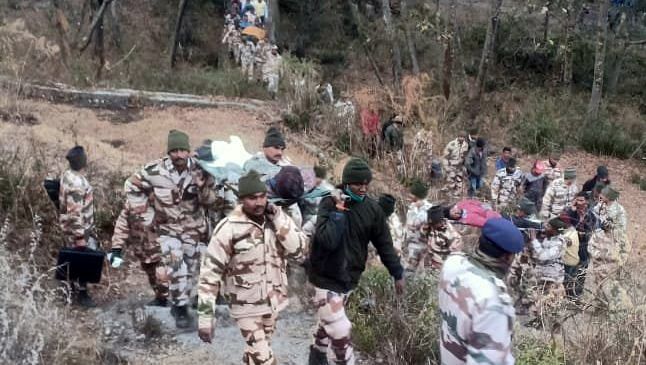
New Delhi: Nearly 200 Indo-Tibetan Border Police (ITBP) personnel along with at least 400 of the Army, besides aerial assets of the Indian Air Force, have been deployed at Ringi Village near Joshimath in Uttarakhand for search and rescue operations after flash flood hit the area Sunday morning.
Meanwhile, naval divers have been kept on standby.
Defence officials said a field hospital has also been established to ensure treatment to the injured civilians, many of whom are workers at the Tapovan power project.
ITBP, which was the first responder, has managed to save 12 people stuck inside a tunnel.
Brave #Himveers of ITBP rescuing trapped persons from the tunnel near Tapovan, #Dhauliganga, #Uttarakhand this evening after 4 hrs of efforts. Total 12 persons were rescued from the tunnel out of which 3 were found unconscious. After first aid, carried on stretchers to road head. pic.twitter.com/iHsrFXjhDd
— ITBP (@ITBP_official) February 7, 2021
Officials said 60 personnel from the NDRF have moved with 5-tonne load from Hindon air base near Delhi to Jolly Grant Airport in Dehradun in an IAF C 130J aircraft.
One more C 130J and one AN 32 are ready at Hindon with additional NDRF personnel. Three IAF Mi 17 choppers have been kept ready at the Jolly Grant airport to transfer NDRF teams to Joshimath.
Additionally, 16 Naval Commandos (Marcos) have been kept ready in Delhi and another 40 in Mumbai for airlift to Ringi village in case of any additional requirement, the officials said.
Based on a request from the state government, the Army has already deployed two columns (about 200 men) from Joshimath and another two columns from Auli in Uttarakhand.
Two additional columns are on standby, the officials said, adding that the Engineering Task Force with two JCBs have also been deployed.
Medical columns with two ambulances have also been deployed besides establishment of a control room in Joshimath to coordinate the entire search and rescue operation.
Crisis management panel meets
The National Crisis Management Committee (NCMC) under the chairmanship of Cabinet Secretary Rajiv Gauba met Sunday to review the situation arising out of the natural disaster caused by a glacier burst.
Uttarakhand Chief Secretary Om Prakash briefed the committee via video conference on the ground situation as well as the actions taken by them after the incident to evacuate people and contain the damage.
The glacial burst led to the rising of water levels in Rishiganga river, which washed away the Rishiganga small hydro project of 13.2 MW.
The flash flood also affected the downstream hydro project of NTPC at Tapovan on the Dhauli Ganga river, a tributary of Alaknanda.
However, there is no danger of downstream flooding and the rise in water level has been contained, according to information given by the Central Water Commission (CWC), the NCMC said in a statement.
There is also no threat to the neighbouring villages, it added.
At the same time, the central and state agencies concerned have been asked to keep a strict vigil on the situation, and a team from the Defence Research and Development Organisation (DRDO), which monitors avalanches, is being flown in for surveillance and reconnaissance.
Subscribe to our channels on YouTube & Telegram
Why news media is in crisis & How you can fix it
India needs free, fair, non-hyphenated and questioning journalism even more as it faces multiple crises.
But the news media is in a crisis of its own. There have been brutal layoffs and pay-cuts. The best of journalism is shrinking, yielding to crude prime-time spectacle.
ThePrint has the finest young reporters, columnists and editors working for it. Sustaining journalism of this quality needs smart and thinking people like you to pay for it. Whether you live in India or overseas, you can do it here.